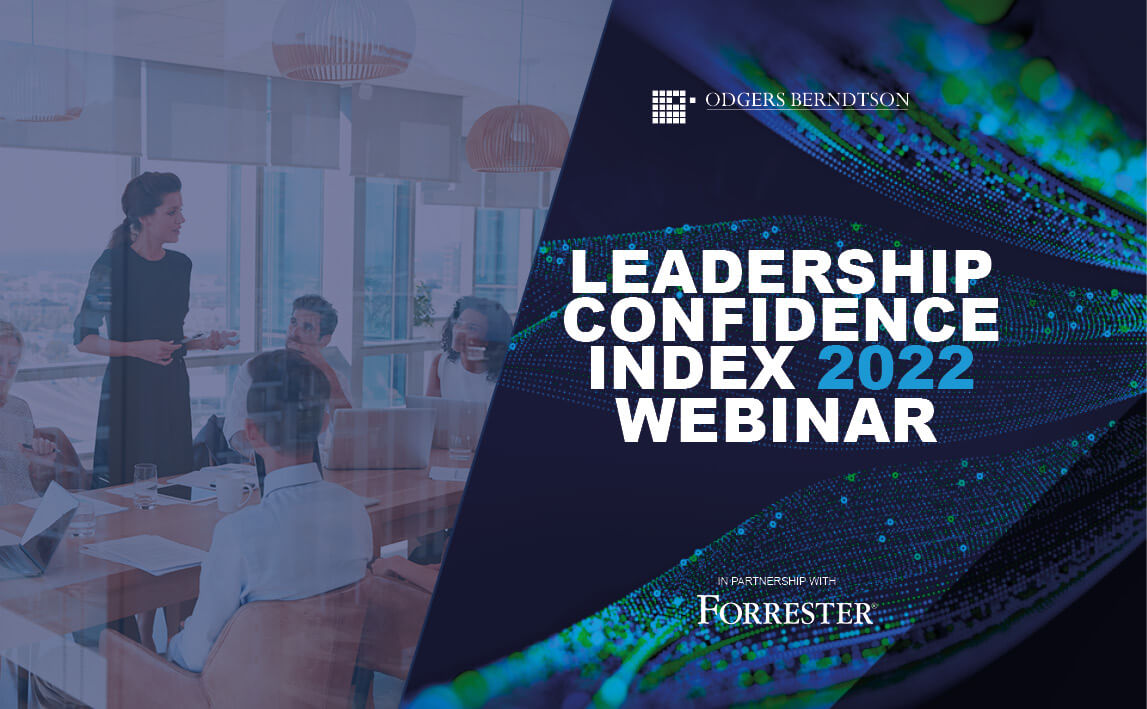In an ever-changing business environment, leadership strategy has never been more important.
Mark Braithwaite, Managing Director of Odgers Berndtson APAC, and James McQuivey, VP, Research Director of Forrester’s Future of Work recently hosted a webinar to discuss this, alongside our recently published Leadership Confidence Index Report. Watch the recent webinar on demand here.
In our recent webinar, James and I explained the impact the pandemic has had on leadership, and explored key themes reflected in the Index’s data – exploring ultimately, what this means for the future of leadership and leaders themselves in a world full of disruption?
In short, leaders must now focus on resilience, technology and all facets of employee wellbeing and inclusion to ensure their organizations remain relevant and competitive.
Leaders are doing better than they were
One of the most interesting discoveries from our latest published report in the Leadership Confidence series is the very distinct growth in confidence that business executives have in their leaders, with the figures in confidence almost doubling over the past two years. This was the biggest question facing our two hosts, why - and what should leaders now need to focus on to get the full support of their board and executives?
Ultimately, the pandemic had a catalyst effect forcing an organization’s leaders to the fore, to actively weather and visibly lead their teams through a global crisis that could not have been prepared for, let alone imagined.
Ready to adapt or risk being left behind
When asked about the confidence in their leaders’ specific skills, it was found that motivation, resilience, and stakeholder management were consistently marked the highest. Given the increased disruption that is almost certainly on the horizon, this is a very positive finding.
However, there is still more work to be done. Data analysis, data acumen, and emotional intelligence were the lowest scored skills indicating that the pandemic was a catalyst in certain areas.
Boards want to replace leaders they believe either can’t - or haven’t - adapted quickly enough to the disruption of the pandemic. The bar for good leadership has become higher as a result.
Technology is now considered an enabler, not a disruptor
Organizations have historically viewed technology as an important element to the running of the business. Although as a result of the pandemic, there was a shift: organizations now need to update their technology platforms to remain competitive, think systems for remote working, cyber security risks, AI and the shift to cloud.
Suddenly technology went from being the ‘thing the CTO did’ to something all executives needed to be involved in. Watch the webinar on demand here.
Our findings show that executives are now intentionally incorporating technology change into their strategic thinking and that they no longer view it as something to be delegated to a specific IT department.
We’re seeing more CTOs and CIOs reporting directly into the CEO, rather than the CFO. The change shows more leaders now want to better understand technology and have the best of - beyond simply how they can reduce the cost of it.
We expect there will be a period of deliberate ‘tech savviness’ amongst leaders, which then moves into a period of assumed tech understanding.
ESG and DE&I took on greater importance
After two years of working from home, values have changed, and individual principles have shifted. The place and purpose of an organization in society is becoming more important. Employees will now join or leave an organization based on whether the organization’s values align with their own.
Our findings regarding both the ESG and DE&I agendas, show that executives fundamentally believe these are critical, and communicating those agendas to employees even more so - but building specific initiatives in support of these agendas is where we saw the least positivity.
If the actions don’t rise to the same level as the aspirations, then organizations risk empty platitudes and our data suggests that this risk is very real.
Very few respondents admitted their organization set leadership diversity targets or had put in place diversity initiatives, for example.
More disruption to come
Our Index shows that 79% of respondents believe disruption in the future will either increase or stay the same, i.e., experience similar levels of disruption that have been caused by the pandemic. Read more on those data findings here.
What is most apparent from the Index series is that change is now a constant.
The most effective leaders will look to use technology to solve the disruption and gain an advantage over their competitors.
A key takeaway for leaders
Any organization can use the data within the report to isolate specific successes as well as targets to focus and build upon.
Download and view the report here.
One such primary confidence indicator throughout the pandemic has been well-being and guidance from their leaders. Simply put, employees that feel looked after have marked higher confidence in their leaders. We believe authentic empathy plays a key role in successful leadership.
From our own experience in searching for top leaders, we know that the accelerated pace of change within organizations is resulting in greater executive turnover and leaders need to adapt, or risk getting left behind.
Watch the webinar on demand here.
To discuss the changing landscape of leadership and your own organizational needs, please do get in touch with us here or your local Odgers Berndtson contact.
Stay up to date: Sign up here to our newsletter and receive the latest news in leadership and top talent, industry insights and events directly to your inbox.



